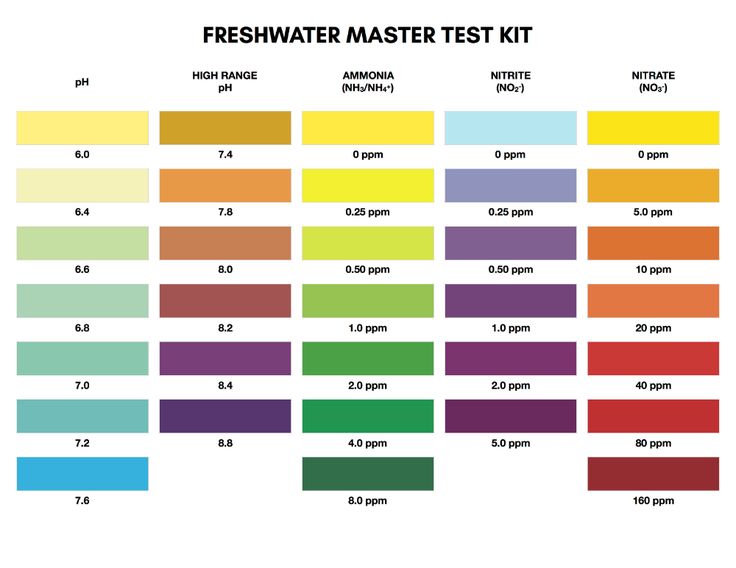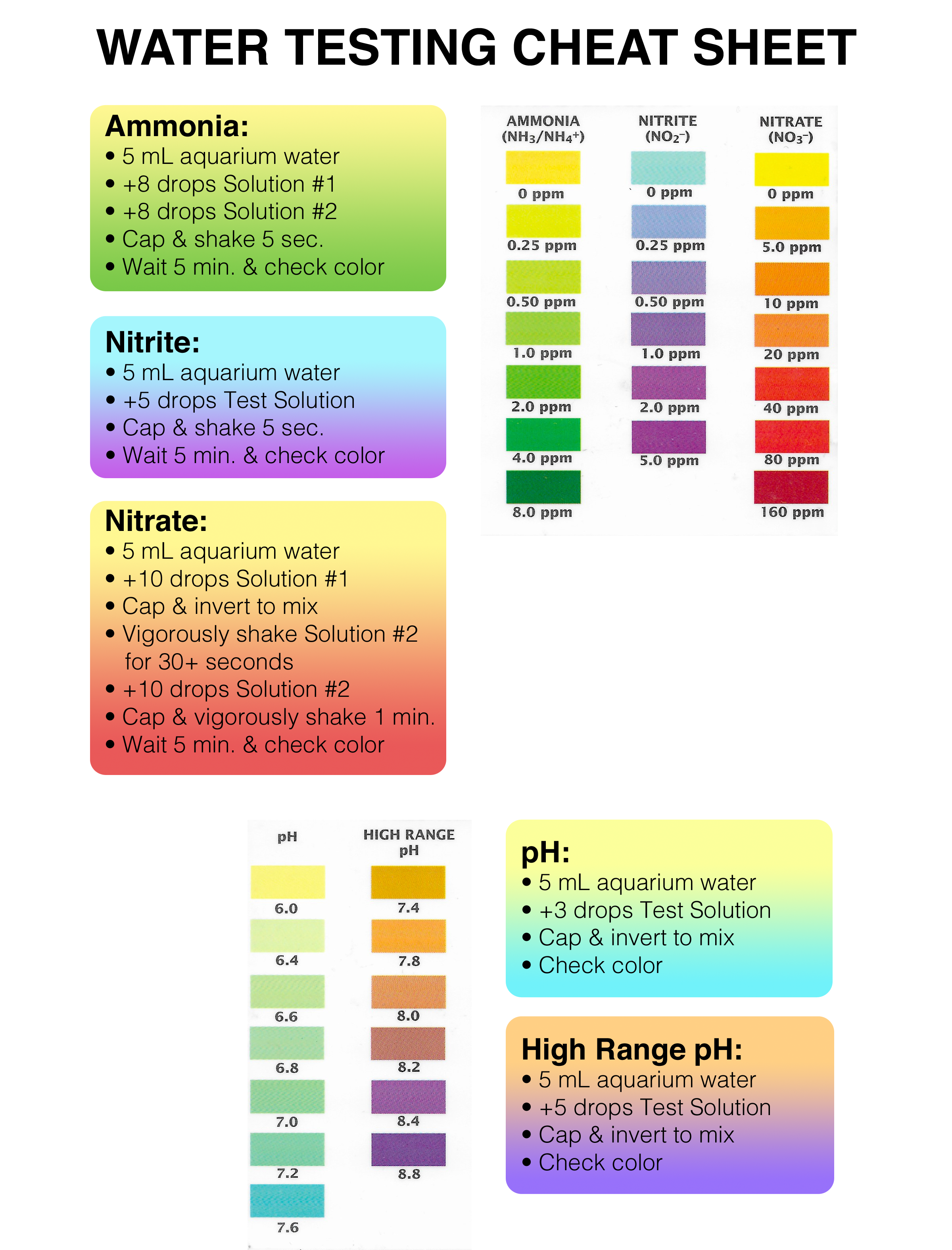Originally posted on May 20, 2023 @ 8:00 pm
Last Updated on 2 months by admin
As a freshwater aquarium owner, you want to make sure your fish are living in a healthy environment. One essential aspect of maintaining a healthy aquarium is testing the water regularly. To do this, you need to understand the color chart that comes with your water testing kit.
The color chart is a key tool in determining the water parameters of your aquarium. By matching the colors of the test results to the chart, you can determine the levels of ammonia, nitrite, nitrate, pH, and other important parameters. This knowledge is crucial in ensuring your fish thrive and your aquarium remains a beautiful, healthy environment.

Understanding the Color Chart for Freshwater Aquarium Water Testing
If you are a freshwater aquarium hobbyist, water testing is a crucial aspect of ensuring that your fish and plants thrive in a healthy environment. One of the most common methods of testing freshwater aquarium water is by using a color chart. However, understanding the color chart can be confusing for beginners. In this article, we will explain how to read the color chart and what they mean.
What is a Color Chart for Freshwater Aquarium Water Testing?
A color chart is a guide that helps you interpret the test results of various water parameters in your aquarium. The chart typically includes a series of color blocks, each representing a specific range of values for a particular parameter, such as pH, ammonia, nitrite, and nitrate. The color blocks range from light to dark shades and correspond to numerical values that indicate the concentration of the parameter in your aquarium water.
To use the color chart effectively, you need to follow the instructions provided with your test kit. Typically, you will need to add a specific number of drops of the testing reagent to your water sample, shake it, and then compare the color of the sample with the corresponding color blocks on the chart.
Understanding the Different Colors on the Chart
The color blocks on the chart are arranged in a specific order and represent different levels of the parameter being tested. For example, the pH color chart may range from 6.0 to 8.5, with each color block representing a 0.5 increment. The lightest color block represents the lowest value, while the darkest color block represents the highest value.
It is important to note that different test kits may have different color charts and scales, so make sure you use the one that corresponds to your kit. Additionally, the color of your water sample may not always match exactly with the color blocks on the chart, so it is essential to choose the one that is closest in hue.
The Benefits of Using a Color Chart for Freshwater Aquarium Water Testing
Using a color chart to test your aquarium water has several advantages. First, it is an affordable and convenient method that does not require advanced scientific knowledge or equipment. Second, it allows you to monitor the levels of various parameters in your aquarium regularly, which is essential for maintaining a healthy environment for your fish and plants.
Moreover, the color chart provides a visual representation of the water parameters, making it easier to identify any potential issues with your aquarium water. For example, if you notice that the color of your ammonia test sample is darker than the safe range, you can take immediate action to address the problem and prevent fish or plant harm.
The Pros and Cons of Using a Color Chart for Freshwater Aquarium Water Testing
Like any other method of testing aquarium water, using a color chart has its advantages and disadvantages. Here are some pros and cons to consider:
Pros:
- Easy to use and understand
- Convenient and affordable
- Allows for regular monitoring of water parameters
- Provides a visual representation of the results
Cons:
- May not be as accurate as other testing methods
- Some color charts may be difficult to read or interpret
- May not detect some water parameters that are important for fish and plants
It is important to remember that using a color chart should not be the only method of testing your aquarium water. It is a supplement to other methods, such as electronic testing devices or laboratory analysis, and should be used in conjunction with them.
Conclusion
In conclusion, understanding the color chart for freshwater aquarium water testing is essential for maintaining a healthy environment for your fish and plants. By following the instructions provided with your test kit and interpreting the color blocks accurately, you can monitor the levels of various parameters in your aquarium water regularly. Remember to use the color chart as a supplement to other testing methods and take immediate action if you detect any potential issues with your aquarium water.
Frequently Asked Questions
What is a freshwater aquarium water testing color chart?
A freshwater aquarium water testing color chart is a tool used to measure and analyze the chemical parameters of the water in a freshwater aquarium. It helps to determine the levels of pH, ammonia, nitrite, and nitrate in the water, which are all crucial for the health and well-being of the fish and other aquatic organisms in the tank. The color chart uses a series of color-coded test strips or liquid reagents that change color according to the levels of each chemical compound in the water.
How do I use a freshwater aquarium water testing color chart?
To use a freshwater aquarium water testing color chart, you first need to collect a water sample from your tank according to the instructions on the test kit. Next, you will need to add the appropriate test strips or liquid reagents to the water sample and wait for the colors to develop. Once the colors have developed, you can match them to the color chart provided with the kit to determine the levels of each chemical parameter in your aquarium water. It’s important to follow the instructions on the test kit carefully to ensure accurate results.
Why is it important to understand the color chart for freshwater aquarium water testing?
Understanding the color chart for freshwater aquarium water testing is important because it helps you to monitor and maintain the chemical balance of your tank’s water. If the levels of pH, ammonia, nitrite, or nitrate are too high or too low, it can be harmful to the fish and other aquatic organisms in the tank. By regularly testing the water and using the color chart to interpret the results, you can make adjustments to the water chemistry as needed to keep your tank healthy and thriving.
What are the consequences of not using a freshwater aquarium water testing color chart?
Not using a freshwater aquarium water testing color chart can lead to a range of problems in your tank. Without regular testing and analysis of the water chemistry, you may not be aware of imbalances or issues that could harm your fish and other aquatic organisms. This can lead to health problems, disease outbreaks, and even death for your aquatic pets. Additionally, without the color chart to guide you, it may be difficult to know how to adjust the water chemistry to keep your tank in optimal condition.
How often should I use a freshwater aquarium water testing color chart?
The frequency of testing your freshwater aquarium water will depend on several factors, including the size of your tank, the number and type of fish and other organisms in the tank, and the filtration system you are using. In general, it is recommended to test your water at least once a week, and more frequently if you notice any changes in the behavior or health of your fish or other aquatic organisms. By regularly using the freshwater aquarium water testing color chart, you can ensure that your tank stays healthy and thriving for years to come.

Api Freshwater Aquarium Master Test Kit – (Step By Step Guide)
In conclusion, understanding the color chart for freshwater aquarium water testing is crucial for maintaining a healthy aquatic environment. By regularly testing the water parameters, you can ensure that the water quality is optimal for your fish and plants to thrive.
Using a color chart may seem daunting at first, but with practice and patience, it can become a quick and easy routine in your aquarium maintenance. Remember to always follow the instructions carefully and use the appropriate testing kit for your specific needs.
Investing in a reliable testing kit and staying on top of water changes and maintenance can ultimately save you time, money, and heartache in the long run. With a little knowledge and effort, you can enjoy a beautiful and healthy aquarium for years to come.
